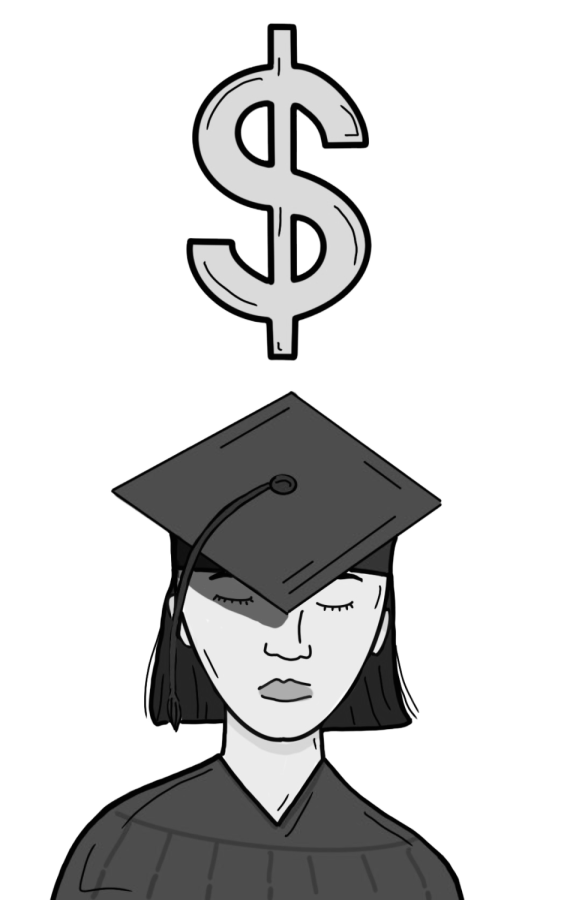Whats Left: Biden’s Student Loan Forgiveness Program
The American College: Ivy-covered walls, late night cramming, grassy knolls and quaint quads – endless opportunity – and also crippling student debt. Each year more and more American high schoolers put themselves through a grueling admission process for a chance at the college experience and the benefits that a college education will provide them as they enter the workforce. However, the current cost of college, in contrast to the current earnings of the average American family, forces most to take out student loans with high-interest rates, which leaves them unable to reap the benefits of the stable income college promises. This dilemma has caused most citizens to ask whether a one-time student loan forgiveness program should continue to be implemented federally.
To understand student debt, we have to understand the scope of its harm. Today total student debt in the U.S. hovers at just around 1.7 trillion dollars. The average American owes roughly $30-$40,000 in student loans, graduating into a world with federal interest rates at 5 percent and private lenders’ interest rates up to 12 percent, according to Nerd Wallet. Most carriers of these loans report their sometimes up to 20-year-long repayment plans have left them unable to consider long-term investments expected of an American their age in previous generations, like homes and cars. Over the course of such generations’ lifetimes, the cost of a four-year college education has risen 130 percent (1990-2022), states the Education Data Initiative. This is most likely, as Westley Whistle writes for New America, because “Unemployment for 18- to 35-year-olds hit 13 percent at the height of the recession in 2010, a time when many Millennials were in high school. Due to such poor labor market conditions, college enrollment spiked as many enrolled in college though they hadn’t planned to originally.” Despite the rising cost of college, the median American family’s earnings since 2000 have only increased by less than $200, according to the U.S. Census and World Population Review. By basic economic logic, student debt payments would boost the quality of life, investment potential and general agency in the long term for those affected by student debt.
The primary stakeholders within the debate over forgiving student debt are not necessarily the blanket student population usually proposed by those against it, which is an important clarification of what issue we are trying to solve. For example, students who attend prestigious private colleges, which can be almost double the price of public institutions, are often intergenerationally wealthy, (think of the legacy and trust fund kids who dominate the Ivy League), and don’t seek out loans in the first place. Many very socioeconomically disadvantaged gain access to financial aid through the FAFSA form which entitles them to loan-free financial aid covered by the schools with large endowment, claiming to be “need blind” or “meeting all demonstrated need.” Because of the merit required to get them through the doors of these usually elite private institutions, they may also have accumulated college funding in the form of private scholarships or grants. Within private institutions, students who fall within a middle ground, whose parents can not afford $50-80,000 tuition a year but who fall within the middle class are most affected because financial aid often underestimates their economic needs and expects their yearly financial contribution to their education to be astronomically high.
At public institutions, on the other hand, both these middle grounders and the extremely socioeconomically disadvantaged are the most affected by student loan debt. These students attending such public colleges, if they are considered high-achieving, may receive some academic or merit-based scholarship/aid from the school or private corporations. However, the students choosing public colleges are usually systematically deprived of opportunities to achieve the same way those tracked into private colleges did to attain this form of economic aid (due to systemic racism, classicism, allocation of resources, etc.). Furthermore, while state schools are exponentially cheaper for in-state residents, there is a large discrepancy in the rankings and robustness of what a state school offers, depending on the state you live in. While California and New York have over 50 public colleges, states with varying levels of prestige and program variety for different types of students, like Oklahoma, may only have 15. This leads many students to have to go out of state for a public education on par with the rigor or programs they desire, which means they are paying closer to the price of private college education than the assumed price of a public college education, leaving them in debt.
For example, according to its website, SUNY Binghamton, a highly ranked public college, has an in-state cost of attendance at $29,784 while costing $47,824 for out-of-state students. As such, the idea conservatives tout that student loan forgiveness “bails out” spoiled children that choose to attend private institutions for “unemployable” degrees like philosophy or classics doesn’t stand. In reality, those with the highest student debt for a bachelor’s degree are curriculum and instruction students who are seemingly taking on seeking employment as teachers or educational administrators who are in high demand. Even students studying within the STEM field, which the right often deems as “responsible,” are left with debts of over $20,000, according to the Education Data Initiative.
Furthermore, as BIPOC/minority/first generation students increase within the student makeup of America (millennials and Gen Z), and are often least likely to have families that can finance their education, the argument that it is unfair to absolve financial “responsibility” that other generations “dealt with” reeks of racism and classism. We can see this narrative take shape when conservatives justify historic acts like the G.I. bill that partially finances higher education for veterans up to ten years after service and pays for full tuition costs while a soldier is in active duty, which started after WWII. However, the only reason the U.S. government favors these programs is that it favors the White men that have always been the primary beneficiaries as they, even today, make up 70 percent of active duty enlisted men. The program usually also tracks low-income Americans into the military with the incentive of a paid education. Conservatives are essentially making the argument that to be responsible BIPOC, low-income, first-generation and other groups marginalized by student debt, even when they make financially sound decisions like attending public colleges for competitive majors, they should offer up their bodies as collateral for violent imperialist causes to pay the price. “My House colleagues and I are very concerned that the deeply flawed and unfair policy of blanket student loan forgiveness will also weaken our most powerful recruiting tool at the precise moment we are experiencing a crisis in military recruiting,” said representative Don Beacon of Nebraska, as noted in Business Insider. Such criticism has been codified in a letter to President Biden sent by 19 members of Congress. Representative Don Meuser of Pennsylvania has gone as far as to say in Time that it is a “moral hazard to forgive self-imposed debt.”
The right’s “I suffered, so you should too” argument against loan forgiveness continues on to their assertion that aspiring college students should choose to pursue careers where a bachelor’s, graduate and doctoral levels of education are not acquired. However, they fail to recognize that, especially for the lower or lower-middle class, social mobility is most dependent on the attainment of education. Only upper-middle-class families can usually afford to finance their children becoming small business owners or working through the ranks of trade until they attain a beyond entry-level position because it is cheaper than college.
The other argument the right employs in their war against loan forgiveness is the idea that at a time when inflation is at an all-time high, allowing more disposable income to circulate will only gouge prices of goods and services higher. However, many economists believe that because owners of student debt have not been making any payments at all since March 2020, due to the CARES Act moratorium, the possibility that sudden debt forgiveness will disrupt the economy because it suddenly will circulate more disposable income will be offset by the fact that those who still owe even after some forgiveness will begin their regular payments again. Inflation will go down simply because people will start repaying again, even if less than before.
I will concede to those against Biden’s already partially implemented Student Loan Forgiveness Program that it is equivalent to placing a bandaid on a gaping wound. Student debt forgiveness, even if only partial, would help this generation survive in our economy, but what happens when private and public colleges continue to raise their tuition and the stigma surrounding trade school community colleges and non-degree careers increases? To truly solve the problem facing middle and lower-class college students after they graduate, our government would need to take comprehensive action potentially including, but not limited to, supporting trade unions and making public and community colleges free for all, thus incentivizing private colleges to lower their prices for the non-elite they want to entice into enrolling to meet racial and socioeconomic “diversity” quotas. We should continue to implement a widespread Student Loan Forgiveness program but also take steps so that “forgiveness” isn’t necessary in the first place.

Emma Barrison is a senior from Watchung, NJ concentrating in studio art with a minor in museum studies. She has previously served as a Graphic Designer....





Bruce Bodner • Oct 24, 2023 at 8:18 pm
Sure, tax those who haven’t gone to college for the privileges of those who have. Sounds very fair. The real truth is that through loans guarantees and all forms of “aid”, the Federal government has been ostensibly trying to “make college affordable” for the past 70 years, so… Of Course it is the segment of the economy which has experienced the highest inflation. Colleges have NO incentive to cut costs, to limit tuition. Their students get loans which are guaranteed by the taxpayer. Colleges get paid even if their graduates stiff the loan agencies. So they compete on how wonderful an experience they give to the little darlings, all on the taxpayers dime.